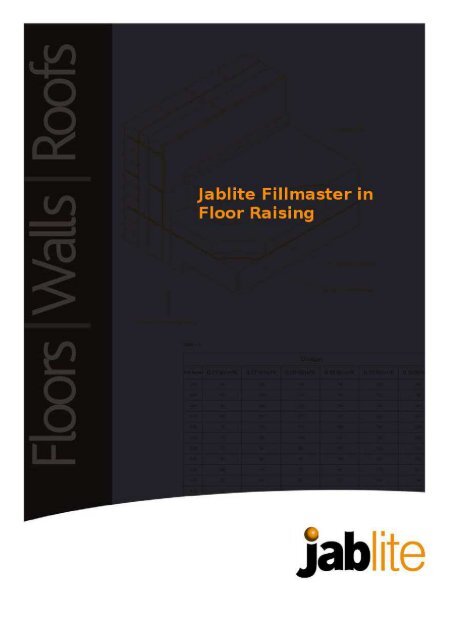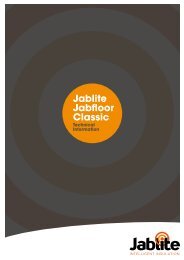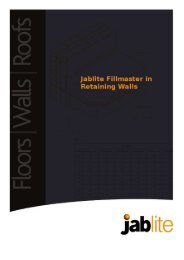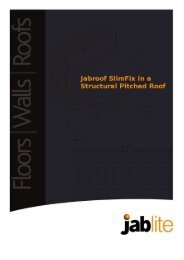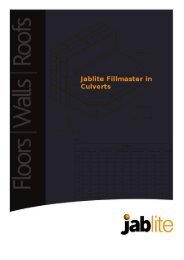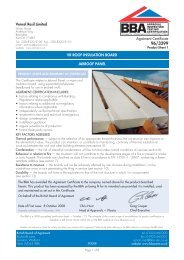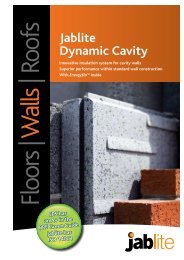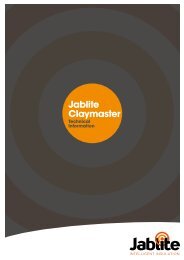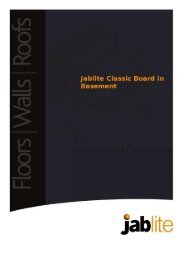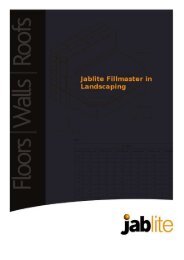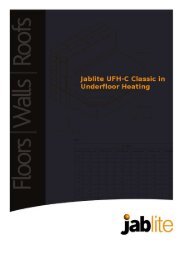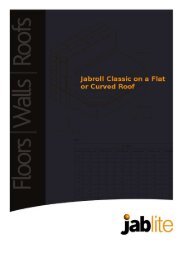Jablite Fillmaster in Floor Raising
Jablite Fillmaster in Floor Raising
Jablite Fillmaster in Floor Raising
Create successful ePaper yourself
Turn your PDF publications into a flip-book with our unique Google optimized e-Paper software.
8<br />
Design Consideration<br />
Traditional fill materials used to construct new embankments or<br />
placed aga<strong>in</strong>st civil eng<strong>in</strong>eer<strong>in</strong>g structures, can cause unacceptable<br />
vertical and/or horizontal stresses <strong>in</strong> the underly<strong>in</strong>g soil or aga<strong>in</strong>st<br />
the structure. The use of <strong>Fillmaster</strong> expanded polystyrene as a fill<br />
material offers a reliable, cost-effective lightweight solution to<br />
these problems, reduc<strong>in</strong>g the probability of further settlement or<br />
unacceptable lateral forces and often simplify<strong>in</strong>g the construction.<br />
Vencel Resil manufactures <strong>Fillmaster</strong> expanded polystyrene (EPS) blocks<br />
for use <strong>in</strong> civil eng<strong>in</strong>eer<strong>in</strong>g projects, especially road construction. The<br />
material is available <strong>in</strong> a range of sizes and strength grades. The cellular<br />
structure of the EPS material gives a high strength-to-weight ratio<br />
ensur<strong>in</strong>g that the blocks are able to withstand the mechanical loads<br />
encountered <strong>in</strong> road construction.<br />
Advantages<br />
■ Lightweight and easy to handle on site. Approximately 1% of the<br />
weight of traditional fill materials.<br />
■ Available <strong>in</strong> a range of grades allow<strong>in</strong>g the appropriate compressive<br />
strength to be chosen to suit each particular application.<br />
■ Closed-cell structure <strong>in</strong>hibits water absorption.<br />
■ Unaffected by normal range of climatic conditions.<br />
■ Immune to <strong>in</strong>sect, bacterial and fungal attack.<br />
Descri ption<br />
Grade<br />
<strong>Fillmaster</strong> is supplied <strong>in</strong> the grades shown <strong>in</strong> Table 1. Normally supplied<br />
as Euroclass F def<strong>in</strong>ed to BSEN 14933: 2007, it is also available as<br />
Euroclass E, flame-retardant additive material, if required.<br />
Dimensions<br />
<strong>Fillmaster</strong> standard block size:<br />
2440 x 1220 x 610mm; other sizes available to order to reduce the<br />
need for cutt<strong>in</strong>g to size on site. The stability of a lightweight<br />
embankment depends greatly on the uniformity of the blocks.<br />
Tolerances: ±3mm on thickness; ±4mm on width; and ±6mm on<br />
length. Maximum bow, 5mm over length of block.<br />
Application<br />
Expanded polystyrene has been successfully used as a fill material for<br />
highway embankments s<strong>in</strong>ce 1972. Its first such use <strong>in</strong> the UK was <strong>in</strong><br />
1985. The material is particularly beneficial <strong>in</strong> the follow<strong>in</strong>g situations<br />
where its use will obviate the need for either specialised foundations,<br />
or long surcharge periods designed to preload the ground and reduce<br />
settlement problems follow<strong>in</strong>g construction:<br />
■ Areas adjacent to exist<strong>in</strong>g embankments.<br />
■ Areas of unstable ground.<br />
■ Areas of weak or compressible soil.<br />
■ Sites where access is difficult or restricted.<br />
■ Ransition zones between bridges or underpasses and normal fill<br />
materials.<br />
Figure 1. HA Load<strong>in</strong>gs<br />
<strong>Fillmaster</strong><br />
blocks<br />
Pavement<br />
construction<br />
Buoyancy<br />
Reduced<br />
deadload of<br />
structure<br />
Compacted<br />
sand-levell<strong>in</strong>g<br />
course
9<br />
Table 1<br />
Physical Properties – <strong>Fillmaster</strong><br />
Design<br />
<strong>Fillmaster</strong> Grade FM50 FM70 FM100 FM150 FM200 FM250 FM300 FM350 FM400 FM500<br />
Compressive<br />
Stress at 1%<br />
stra<strong>in</strong> (kPa)<br />
Embankment forces<br />
There are three ma<strong>in</strong> design considerations when construct<strong>in</strong>g<br />
embankments us<strong>in</strong>g <strong>Fillmaster</strong>:<br />
10 20 45 70 90 100 120 140 160 190<br />
■ Downward pressure due to wheel load<strong>in</strong>gs and the self-weight of the<br />
embankment.<br />
■ Upward forces due to buoyancy <strong>in</strong> wet conditions.<br />
■ Lateral forces act<strong>in</strong>g aga<strong>in</strong>st abutments.<br />
Wheel load<strong>in</strong>gs<br />
In order to avoid unacceptable deflections and permanent deformation<br />
of the highway surface, the compressive stresses due to wheel load<strong>in</strong>gs,<br />
etc., should be carefully calculated and the appropriate grade of<br />
<strong>Fillmaster</strong> selected to ensure that these fall with<strong>in</strong> the design<br />
compressive strength of the material. It is recommended that this is<br />
carried out <strong>in</strong> accordance with the method of calculation for the<br />
thickness of sub-base/subgrade set out <strong>in</strong> BS 5400. This uses the<br />
convention of ‘HA’ and ‘HB’ units of load<strong>in</strong>g.<br />
HA load<strong>in</strong>g assumes a s<strong>in</strong>gle 100kN wheel load exert<strong>in</strong>g a pressure of<br />
1110kPa over a square of 300 x 300mm; the pressure is exerted<br />
downwards at a gradient of 2:1. This represents the effects of normally<br />
permitted vehicles.<br />
Design Consideration<br />
HB load<strong>in</strong>g represents the effects of abnormal loads on motorways and<br />
trunk roads. It is usual to design for 45 units of HB load<strong>in</strong>g; this<br />
represents the effect of 16 wheel loads each of 112.5kN exert<strong>in</strong>g a<br />
pressure of 1110kPa over a square of 318 x 318mm. The pressure is<br />
dispersed downwards at a gradient of 2:1.<br />
See Figures 2 and 3.<br />
Figure 2. HA Load<strong>in</strong>gs<br />
Depth <strong>in</strong> metres<br />
below surface<br />
100<br />
70<br />
45<br />
27<br />
21<br />
S<strong>in</strong>gle nom<strong>in</strong>al<br />
wheel HA load<strong>in</strong>g<br />
1 x 100kN<br />
Figure 3. HB Load<strong>in</strong>gs<br />
Depth <strong>in</strong> metres<br />
below surface<br />
4 x 112.5 4 x 112.5 4 x 112.5 4 x 112.5<br />
Approx pressure kN/m 2<br />
45 Units of<br />
HB Load<strong>in</strong>g<br />
For technical <strong>in</strong>formation 0870 444 8769 technical@vencel.co.uk
10<br />
Design Consideration<br />
Downward pressure<br />
When calculat<strong>in</strong>g the self-weight of <strong>Fillmaster</strong> blocks an allowance<br />
should be made for water absorption of less than 1% by volume.<br />
This gives a design weight of approximately 100kg/m 3 .<br />
Buoyancy pressures<br />
EPS is a proven flotation material and exerts a flotation force of<br />
900kgf/m 3 .<br />
This takes <strong>in</strong>to account a potential level of water absorption of 8% for<br />
blocks which are permanently submerged.<br />
Care must be taken dur<strong>in</strong>g the design process to ensure that the<br />
potential flotation forces can be accommodated with<strong>in</strong> the<br />
hydrological conditions of the site and take account of the self weight<br />
of the permanent structure.<br />
Alternatively, the material can be <strong>in</strong>stalled above the water table.<br />
The water table can be lowered by <strong>in</strong>stall<strong>in</strong>g suitable cut-off dra<strong>in</strong>s at<br />
the toe of the embankment or beneath the embankment itself.<br />
Lateral pressures<br />
When us<strong>in</strong>g <strong>Fillmaster</strong> for approach embankments to bridge<br />
abutments, the horizontal forces exerted on the abutment are almost<br />
eradicated. This allows economies to be made <strong>in</strong> the design of bridge<br />
foundations, which are no longer required to resist large rotational<br />
moments.<br />
Installation<br />
Construction of the embankment should proceed as follows:<br />
Levell<strong>in</strong>g course<br />
<strong>Fillmaster</strong> blocks are placed on a levell<strong>in</strong>g course consist<strong>in</strong>g of a layer of<br />
compacted sand to a maximum thickness of 100mm. This course<br />
should be laid to a level tolerance not exceed<strong>in</strong>g ±10mm over any 3m<br />
length. On sites which have very soft foundations, a geotextile layer<br />
may be placed on top of the soft soil before plac<strong>in</strong>g the sand fill, this<br />
prevents the sand from be<strong>in</strong>g ‘punched’ <strong>in</strong>to the soil.<br />
Lay<strong>in</strong>g the blocks<br />
The blocks <strong>in</strong> each layer should be laid with broken jo<strong>in</strong>ts; there should<br />
be no vertical or horizontal jo<strong>in</strong>ts runn<strong>in</strong>g through the construction.<br />
There is no need to compact the blocks dur<strong>in</strong>g construction.<br />
The coefficient of friction (µ) between adjacent blocks can be taken as<br />
0.5; this is normally sufficient to prevent any slippage or movement.<br />
When required, for example at the edges of the embankment,<br />
a positive fix<strong>in</strong>g can be obta<strong>in</strong>ed by driv<strong>in</strong>g 12mm diameter re<strong>in</strong>forc<strong>in</strong>g<br />
bars down through the layers.<br />
The f<strong>in</strong>al profile of the side slope will depend on the properties of the<br />
soil used. Where soil conditions restrict the available space for an<br />
embankment, a range of techniques is now available for construct<strong>in</strong>g<br />
steep sides or vertical faces.<br />
Cutt<strong>in</strong>g<br />
Blocks which require trimm<strong>in</strong>g can be easily cut us<strong>in</strong>g a hot-wire cutter,<br />
handsaw or cha<strong>in</strong> saw.<br />
Protection<br />
The <strong>Fillmaster</strong> should be protected from possible accidental contact<br />
with petroleum or solvents us<strong>in</strong>g a suitable polymer barrier, where<br />
necessary.<br />
Fill or capp<strong>in</strong>g layer<br />
The f<strong>in</strong>al fill should be placed over the <strong>Fillmaster</strong> blocks tak<strong>in</strong>g care not<br />
to puncture any membrane.<br />
No construction plant, other than compaction equipment, should be<br />
driven across, or placed on the <strong>Fillmaster</strong> until there is a m<strong>in</strong>imum<br />
cover of 200mm of acceptable fill material, or until the capp<strong>in</strong>g layer<br />
has been placed.<br />
Vibratory compaction plant should not be used with<strong>in</strong> 500mm<br />
vertically, or 2m laterally, of the <strong>Fillmaster</strong> blocks.<br />
Cover<br />
The sides of the <strong>Fillmaster</strong> blocks should be covered with general fill<br />
and compacted <strong>in</strong> layers. The sides should be graded and covered with<br />
top soil. The m<strong>in</strong>imum cover should be 300mm.<br />
References<br />
BS 5400 Steel, concrete and composite bridges. Part 2 Specification for loads. Department of Transport Standard BD 37/88. Loads for highway bridges.<br />
Geotechnical considerations and techniques for widen<strong>in</strong>g highway earthworks. Department of Transport.<br />
Plastic foam <strong>in</strong> road embankments. Proceed<strong>in</strong>gs of the conference of the Norwegian Plastics Federation. June 1985.<br />
TRL Contractor report 356. The use of polystyrene for embankment construction.
11<br />
Design Consideration<br />
For technical <strong>in</strong>formation 0870 444 8769<br />
technical@vencel.co.uk
32<br />
<strong>Floor</strong> Rais<strong>in</strong>g<br />
<strong>Fillmaster</strong> provides a fast economic solution <strong>in</strong> the conversion of<br />
exist<strong>in</strong>g <strong>in</strong>dustrial build<strong>in</strong>gs when rais<strong>in</strong>g the exist<strong>in</strong>g floor levels.<br />
The lightweight material reduces load on the exist<strong>in</strong>g floor structure<br />
and exerts no lateral force on the exist<strong>in</strong>g walls. This elim<strong>in</strong>ates any<br />
requirement for strengthen<strong>in</strong>g of the exist<strong>in</strong>g structure. Multiple<br />
layers can be placed below the new floor slab produc<strong>in</strong>g any height<br />
required.<br />
Figure 23. <strong>Floor</strong> Rais<strong>in</strong>g<br />
Concrete slab<br />
Nom<strong>in</strong>al gap<br />
<strong>Fillmaster</strong> <strong>in</strong> layers<br />
Damp-proof membrane<br />
Exist<strong>in</strong>g floor level
33<br />
Figure 24. <strong>Floor</strong> Rais<strong>in</strong>g<br />
Nom<strong>in</strong>al gap<br />
Concrete Slab<br />
<strong>Fillmaster</strong><br />
<strong>in</strong> layers<br />
Dock leveller at ASDA, Belvedere, Kent<br />
6,000 square metres of <strong>Fillmaster</strong> was used to construct a dock leveller<br />
<strong>in</strong>side a warehous<strong>in</strong>g unit for ASDA <strong>in</strong> Kent. The floor level of the<br />
build<strong>in</strong>g was raised by 1.1 metres to allow vehicles to reverse up to the<br />
new floor level, to make load<strong>in</strong>g and unload<strong>in</strong>g much quicker and<br />
easier. The material was then covered with a 200mm concrete slab.<br />
<strong>Fillmaster</strong> provided the perfect solution because be<strong>in</strong>g so close to the<br />
River Thames, the added weight of traditional fills would have caused<br />
high levels of settlement, with possible implications for the exist<strong>in</strong>g<br />
foundations. The lateral forces created by the traditional fill would have<br />
created issues with the perimeter wall. The alternative, of excavat<strong>in</strong>g<br />
around the build<strong>in</strong>g was not an option either because of the relatively<br />
high water table caused by the proximity to the river. <strong>Fillmaster</strong><br />
provided a very cost effective method of achiev<strong>in</strong>g the required <strong>in</strong>fill to<br />
create the dock leveller, mak<strong>in</strong>g for a much more functional build<strong>in</strong>g.<br />
<strong>Floor</strong> Rais<strong>in</strong>g<br />
Client: ASDA<br />
Consult<strong>in</strong>g Eng<strong>in</strong>eer: RPS Burkes Green<br />
Exist<strong>in</strong>g floor<br />
level<br />
Damp-proof<br />
membrane<br />
Contractor: Harris Construction Management<br />
Volume: 4500m 3<br />
Royal Mail sort<strong>in</strong>g office at Thurrock, Essex<br />
Royal Mail sort<strong>in</strong>g office at Thurrock, Essex<br />
<strong>Fillmaster</strong> provided the perfect fill material for rais<strong>in</strong>g the floor level of<br />
an exist<strong>in</strong>g build<strong>in</strong>g <strong>in</strong> Thurrock, Essex. The build<strong>in</strong>g was be<strong>in</strong>g converted<br />
to enable the relocation of the Royal Mail, East London Network Hub<br />
sort<strong>in</strong>g office from another site.<br />
The level of the floor and the truck beds needed to be the at the same<br />
height, therefore the exist<strong>in</strong>g floor <strong>in</strong> the build<strong>in</strong>g needed to be raised<br />
by just over 1 metre to enable easier load<strong>in</strong>g of vehicles. Civil and<br />
structural eng<strong>in</strong>eer<strong>in</strong>g contractor Curt<strong>in</strong>s Consult<strong>in</strong>g had concerns that<br />
traditional fill materials would add unnecessary pressures on the ground<br />
below. Use of traditional fill would also have exerted lateral forces on<br />
the perimeter wall, which could have caused damage to the structure of<br />
the build<strong>in</strong>g.<br />
In total 3000m 3 of <strong>Fillmaster</strong> 150E was supplied <strong>in</strong> two layers of<br />
535mm deep, which were loose laid, covered with a damp proof<br />
polythene membrane and f<strong>in</strong>ished with a 150mm thick concrete slab.<br />
All the material was <strong>in</strong>stalled with<strong>in</strong> four days by ma<strong>in</strong> contractor<br />
Fitzpatrick.<br />
As the sort<strong>in</strong>g office was located relatively close to the River Thames,<br />
over the long term, the added weight of traditional fills could have<br />
caused high levels of settlement, with possible implications for the<br />
exist<strong>in</strong>g foundations.<br />
Client: Royal Mail<br />
Consult<strong>in</strong>g Eng<strong>in</strong>eer: Curt<strong>in</strong>s Consult<strong>in</strong>g<br />
Contractor: Fitzpatrick<br />
Volume: 3000m 3<br />
For technical <strong>in</strong>formation 0870 444 8769 technical@vencel.co.uk
44<br />
Technical Data<br />
Table 5. Physical Properties – <strong>Fillmaster</strong><br />
Physical Properties - <strong>Fillmaster</strong><br />
<strong>Fillmaster</strong> Grade FM50 FM70 FM100 FM150 FM200 FM250 FM300 FM350 FM400 FM500<br />
Compressive<br />
Stress at 1%<br />
stra<strong>in</strong> (kPa)<br />
10 20 45 70 90 100 120 140 160 190<br />
Biological properties<br />
EPS is not susceptible to attack by fungus or bacteria and is<br />
non-biodegradable. It offers no nourishment to vegetation or<br />
animal life.<br />
Chemical resistance<br />
EPS is resistant to most substances which occur naturally <strong>in</strong> soil, as well<br />
as to a wide range of common substances at ambient temperatures,<br />
<strong>in</strong>clud<strong>in</strong>g:<br />
■ alkalis<br />
■ dilute <strong>in</strong>organic acids<br />
■ gypsum plaster<br />
■ most alcohols<br />
■ portland cement<br />
■ silicone oil<br />
■ solvent-free bitumen<br />
If there is any possibility that the soil with which it is likely to come<br />
<strong>in</strong>to contact is contam<strong>in</strong>ated, for example when construct<strong>in</strong>g<br />
embankments on reclaimed <strong>in</strong>dustrial land, laboratory tests should be<br />
conducted to determ<strong>in</strong>e the exact nature of the contam<strong>in</strong>ants. Some<br />
materials, <strong>in</strong>clud<strong>in</strong>g vegetable oils, paraff<strong>in</strong>, animal fats and oils may<br />
attack the surface of the EPS caus<strong>in</strong>g shr<strong>in</strong>kage and deformation.<br />
However, they are not able to dissolve the EPS nor to penetrate the<br />
mass of the material and do not affect long-term stability.<br />
Durability<br />
When correctly specified and <strong>in</strong>stalled as a lightweight embankment<br />
fill, <strong>Fillmaster</strong> can be considered as a permanent material. <strong>Fillmaster</strong><br />
also has the added advantage of be<strong>in</strong>g floor-proof.<br />
Mechanical properties<br />
EPS behaves as a l<strong>in</strong>ear elastic material up to stra<strong>in</strong>s of 1% where the<br />
elastic limit is exceeded. A typical stress stra<strong>in</strong> curve is shown <strong>in</strong> Graph<br />
3. <strong>Fillmaster</strong> creep deformation can be disregarded <strong>in</strong> embankment<br />
applications.<br />
The coefficient of friction (µ) between blocks is around 0.5 along the<br />
moulded faces; the figure is higher on cut faces s<strong>in</strong>ce the surface<br />
roughness is <strong>in</strong>creased.<br />
Poissons ratio 0.02.<br />
Moisture properties<br />
EPS is not soluble <strong>in</strong> water and will not usually exceed a moisture<br />
absorption level of 8-10% after long-term immersion.<br />
The closed-cell structure prevents the migration of liquids through the<br />
mass of the material.<br />
Graph 2. Typical stress stra<strong>in</strong> curve<br />
EPS should not allowed to come <strong>in</strong>to contact with hydrocarbons,<br />
chlor<strong>in</strong>ated hydrocarbons, organic solvents such as ketones, ethers and<br />
esters; diesel and petroleum fuels; and concentrated acids.<br />
If there is any possibility of contact with these substances, either<br />
dur<strong>in</strong>g or after construction, the material should be protected by us<strong>in</strong>g<br />
an impermeable polymer membrane as a physical barrier. Further<br />
<strong>in</strong>formation is available from Vencel Resil’s technical services<br />
department.<br />
Stress<br />
1 Stra<strong>in</strong> (%)<br />
10
45<br />
Fire<br />
<strong>Fillmaster</strong> is normally supplied as Euroclass F material as def<strong>in</strong>ed <strong>in</strong><br />
BS EN 14933: 2007; Euroclass E, flame-retardant additive material is<br />
also available. EPS will ignite on contact with an open flame and will<br />
burn readily <strong>in</strong> the presence of air. Care should be taken dur<strong>in</strong>g<br />
construction to ensure that the material is not exposed to possible<br />
sources of ignition. The use of the flame-retardant additive material will<br />
<strong>in</strong>hibit the early stages of the development of a fire.<br />
Small quantities of residual blow<strong>in</strong>g agent may be present and advice<br />
should be sought from Vencel Resil’s technical services department<br />
when <strong>in</strong>corporat<strong>in</strong>g the product <strong>in</strong> areas of low natural ventilation.<br />
Fire is not normally a hazard once the material has been placed and<br />
covered.<br />
Combustion<br />
EPS is ‘combustible’ as def<strong>in</strong>ed <strong>in</strong> BS 476:Part 4. When burn<strong>in</strong>g,<br />
EPS behaves like other hydrocarbons such as wood and paper.<br />
For Euroclass F material, the products of uncontrolled combustion are<br />
carbon monoxide, carbon dioxide, styrene, and water vapour; the<br />
decompos<strong>in</strong>g styrene will emit a certa<strong>in</strong> amount of dense black soot.<br />
Euroclass E material also emits hydrogen bromide when burn<strong>in</strong>g.<br />
Ignition temperature<br />
Flash ignition temperature is between 350 and 490ºC depend<strong>in</strong>g on<br />
the application and the exact circumstances of use. Under certa<strong>in</strong><br />
circumstances the material can be readily ignited by a naked flame,<br />
but provid<strong>in</strong>g it is correctly <strong>in</strong>stalled this does not present any<br />
disadvantage <strong>in</strong> use.<br />
Calorific value: 40MJ/kg.<br />
Specific heat capacity: 1.13kJ/kgºC.<br />
Environmental issues<br />
EPS does not conta<strong>in</strong> or produce HCFCs, nor are these compounds used<br />
<strong>in</strong> its manufacture. In use, it is non-toxic, non-irritant and odourless.<br />
Due to the high volume and low weight of a lorry load of <strong>Fillmaster</strong><br />
there are environmental advantages over traditional materials <strong>in</strong><br />
reduc<strong>in</strong>g the number of lorry runs required to supply a contract.<br />
This can be particularly advantageous <strong>in</strong> built-up environments.<br />
(90m 3 of EPS compared to typically 10m 3 of traditional fill per<br />
lorry load).<br />
The low density of <strong>Fillmaster</strong>, which is typically 95-98% air, directly<br />
reduces the volumes of quarried materials required.<br />
Health & Safety<br />
EPS scores particularly highly when it comes to health and safety. It has<br />
many positive attributes, not the least of which is its proven safety<br />
record from production through useful life to recycl<strong>in</strong>g. EPS is non-toxic<br />
and biologically <strong>in</strong>ert. The material is not irritat<strong>in</strong>g to the sk<strong>in</strong> or eyes;<br />
no medical treatment or action is required as a result of accidental<br />
<strong>in</strong>gestion.<br />
No special precautions are required dur<strong>in</strong>g handl<strong>in</strong>g or cutt<strong>in</strong>g where<br />
carried out <strong>in</strong> a well ventilated area. Dust produced by cutt<strong>in</strong>g is very<br />
light and may cl<strong>in</strong>g to the sk<strong>in</strong> or cloth<strong>in</strong>g through static electricity;<br />
it may be simply brushed away.<br />
The volume of air <strong>in</strong> EPS boards is 98%, consequently the components<br />
<strong>in</strong> a given volume are correspond<strong>in</strong>gly low, typically 15 to 50 kg/m 3 .<br />
In polystyrene, styrene monomer, shown to be safe <strong>in</strong> use, constitutes<br />
up to 0.1% by weight of the product. This m<strong>in</strong>ute trace of styrene<br />
monomer constitutes no threat to health.<br />
The expand<strong>in</strong>g agent pentane, is a saturated hydrocarbon (not to be<br />
confused with (HCFCs) and is non-toxic and constitutes no threat<br />
to the ozone layer. Euroclass E, flame-retardant additive material,<br />
conta<strong>in</strong>s around 0.5% of the flame retardant hexabromocyclododecane<br />
(HBCDD) which is entrapped <strong>in</strong> the polymer matrix of the EPS.<br />
The HBCDD additive should not be confused with aromatic flame<br />
retardants (such as PBBs and PBBOs).<br />
Technical Data<br />
For technical <strong>in</strong>formation 0870 444 8769 technical@vencel.co.uk
For more <strong>in</strong>formation about<br />
<strong>Jablite</strong> please contact us on:<br />
Tel: 0870 600 3666<br />
Email: sales@jablite.co.uk<br />
Visit: www.jablite.co.uk<br />
<strong>Jablite</strong> Limited<br />
Head Office: Inf<strong>in</strong>ity House, Anderson Way, Belvedere, Kent DA17 6BG


